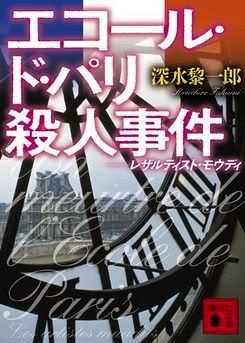 Famous art dealer Akatsuki Hiroyuki is found stabbed by an army knife in a locked room of his own mansion/gallery. Door and window are locked, but a streak of the victim's blood is found on the window's lock and footprints in the sand of the garden below suggest an intruder's work. What would he gain from creating this locked room though? Is the key to solve this mystery concealed in Akatsuki's art book about the École de Paris?
Famous art dealer Akatsuki Hiroyuki is found stabbed by an army knife in a locked room of his own mansion/gallery. Door and window are locked, but a streak of the victim's blood is found on the window's lock and footprints in the sand of the garden below suggest an intruder's work. What would he gain from creating this locked room though? Is the key to solve this mystery concealed in Akatsuki's art book about the École de Paris?This novel features occasionally intermixed chapters from said book. Yes, this is a prime example of 薀蓄ミステリ, mystery novels including a vast stock of knowledge (unchiku) of certain fields. In this case it's the School of Paris consisting of various mostly non-French artists living and painting in Paris at the end of the 19th and the beginning of the 20th century, each having their own style. The art book points out the correlation between each artist's (Soutine, Pascin or Kisling to name a few) work and lifecourse, which makes the whole topic much more interesting than just looking up their pictures on the net.
For me unchiku novels walk on a thin line between unrelatedness and enrichment of the main plot. In this case it worked fairly well. The info on that particular field was more intriguing than I expected, but that might not work for any reader since I guess there has to be at least some basic interest in art or otherwise this novel won't grab hold anywhere on you. What's certainly well done though is the connection to the case and the solution. One of the most essential hints lies hidden in the art book but as all the other clues throughout the novel it's exposed forthright and fair. Fukami Reichirou does not conceal any facts, he does throw some surpises at the reader in the end though.
The unraveled motive is top-notch and dramatic and made me care for the culprit since... long. The plot development dragged a little at first but the finale totally made up for that and while I was a little disappointed that Shinsenji Shunichirou, the (more or less) detective figure and easily the most enthralling character in this novel, did not interact as much with the other characters and their investigation as I wanted him to, the solution of the case explained and legitimated that downside eventually.
The downside of the trick's explanation was that it wasn't as complex and ingenious as I always hope for locked rooms to turn out. The locked room almost takes a back seat in the denouement and turned out as one of those solutions I've never really liked that much, but that's just a subjective opinion since it does not make the foreshadowing and the clues any less complex yet fair. The puzzle itself is still pretty orthodox and neat and all, I just thought the challenge to the reader came up too early considering all the stuff that happened after that. Granted, the reader was only supposed to guess whodunnit and howdunnit, but still I think too many new facts where mentioned afterwards.
Nevertheless this is a rather innovative and yet so classic and orthodox example of topical neo-orthodox detective fiction and I might actually follow the paperback releases by Fukami Reichirou to see if he can hold up his orthodox puzzlers and whether the following works feel more like a detective novel than a police novel. I found Shunichirou to be pretty awesome and unique I have to admit. A 24 years old NEET/freeter who has lived in Europe for 6 years has some pretty hefty remarks on Japanese people and their society going for. And it's just plain fun to read his opinions and quirks so I'll be looking forward to those novels who tell about his time in Europe and the cases he encountered there.
No comments:
Post a Comment